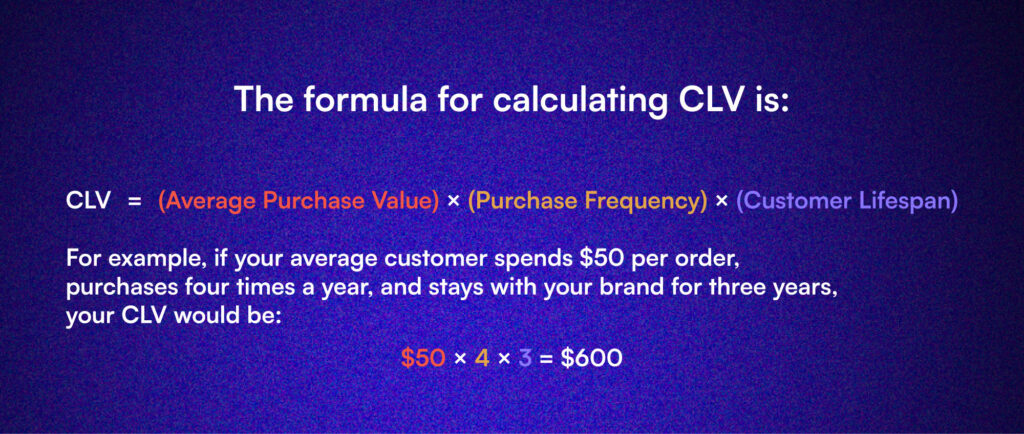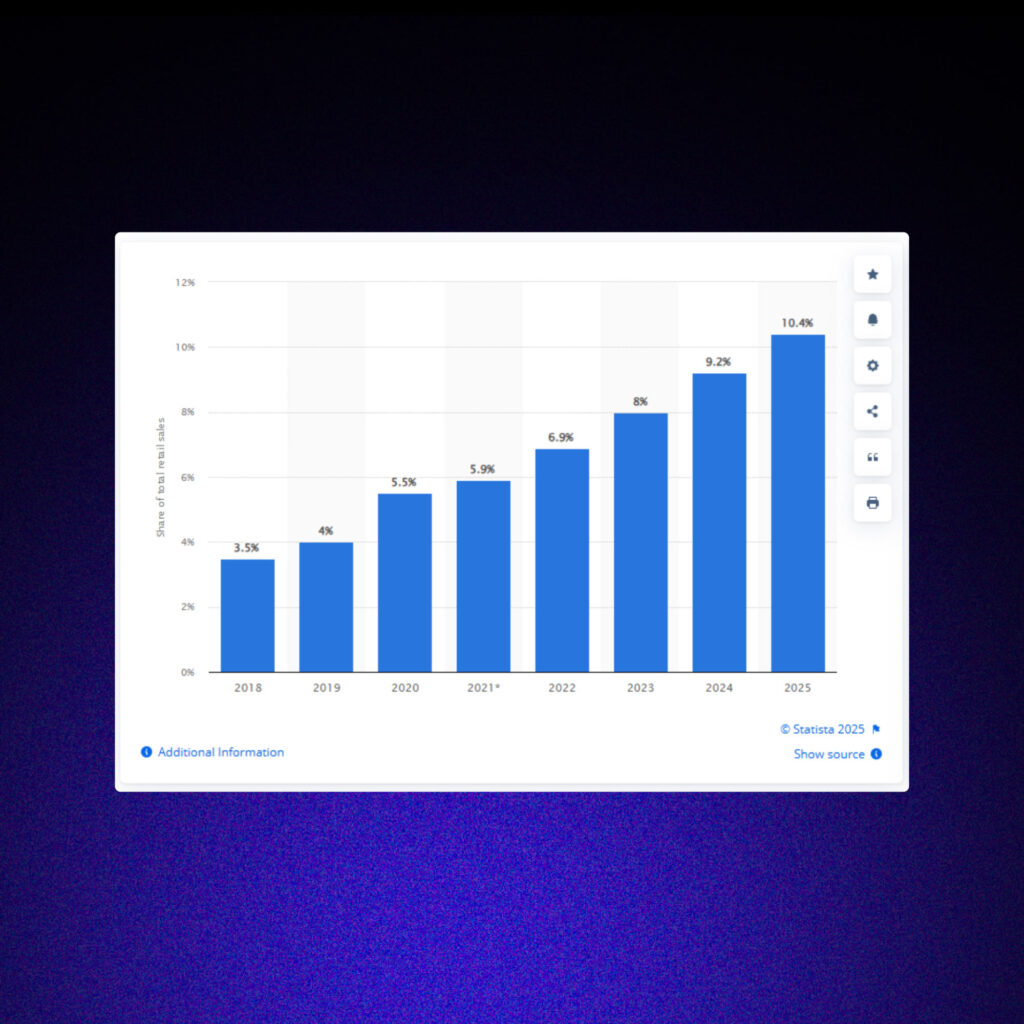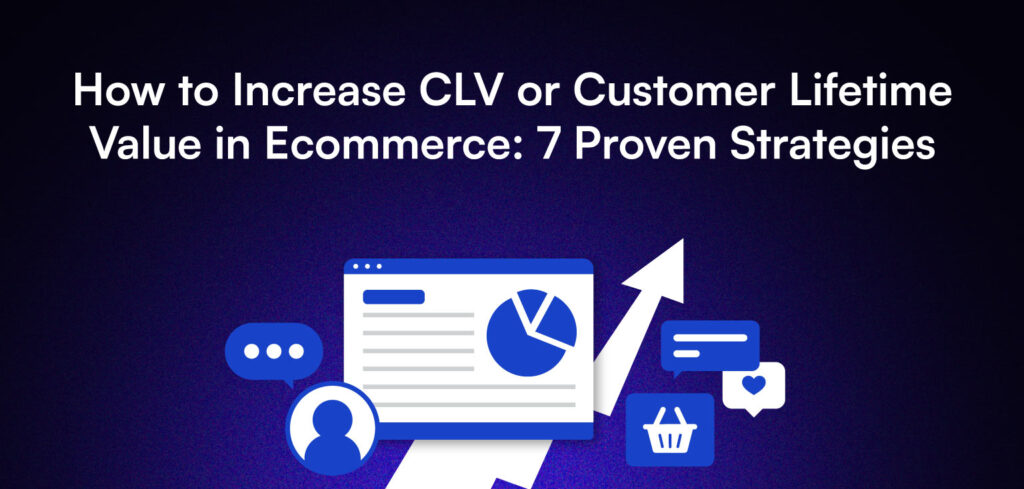Customer Lifetime Value (CLV) isn’t just another eCommerce metric—it’s the heartbeat of a profitable business.
It tells you how much revenue a customer brings in over the course of their relationship with your brand. The higher the CLV, the more loyal your customers are, the more they spend, and the stronger your long-term growth.
The problem?
Too many businesses pour all their energy into getting new customers while neglecting the ones they already have.
But if you want real, lasting growth, retention needs to be a priority.
Want to know how to increase CLV and turn one-time buyers into repeat customers?
Let me walk you through.
What is Customer Lifetime Value (CLV)
Customer Lifetime Value (CLV) is the total amount a customer is expected to spend with your business over time.
It’s a key metric that can shape your strategy, and how you approach it depends on your goals and what you want to get out of your business.
It helps you understand how much you should invest in acquiring and retaining customers.
A higher CLV means your business is maximizing revenue from existing customers rather than constantly relying on new ones.
How to Calculate CLV (Without the Headache)
Ever wonder how much a customer is actually worth to your business over time?
CLV might sound complex, but don’t worry—we’re keeping it simple.
Here’s how to figure it out:
- Estimate how long a customer sticks around – How long do customers typically stay engaged with your business? This helps you understand their lifecycle.
- Predict their future purchases – Look at buying patterns to estimate how much they’ll spend over time.
- Factor in costs – Don’t forget production, fulfillment, and customer service costs.
- Calculate revenue value – Once you have the numbers, apply some simple math to determine their long-term value.
Step-by-Step Guide to Calculating CLV
To get a solid CLV, you’ll need these key numbers:
- Average Purchase Value – Take your total revenue in a given period and divide it by the number of purchases.
- Average Purchase Frequency Rate – This tells you how often the average customer buys from you.
- Customer Value – Multiply Average Purchase Value by Purchase Frequency Rate to see what an average customer is worth per cycle.
- Customer Lifespan – How long does a customer usually stay active before moving on?
- Forecast Revenue – Now, multiply Customer Value by Customer Lifespan to get an estimate of how much revenue you can expect from an average customer.

7 Proven Strategies on How to Increase CLV
Here are the 7 effective strategies on how to increase CLV or your Customer Lifetime Value:
1. Deliver an Exceptional Customer Experience
A smooth, hassle-free shopping experience keeps customers coming back, while a frustrating one drives them away.
How to optimize customer experience:
- Fast & Intuitive Website – Your website should load quickly and be easy to navigate. A slow or complicated site makes it harder for customers to complete purchases.
- Top-Notch Customer Support – Provide multiple support options like live chat, email, and phone so customers can get help quickly. Responsive, helpful service builds trust and encourages repeat business.
- Seamless Mobile Experience – Many shoppers browse and buy on their phones. A mobile-friendly site ensures they can shop effortlessly, no matter where they are.
As a matter of fact, by 2025, mobile commerce is expected to make up over 10% of all retail sales in the US—a nearly 7% increase since 2018.

2. Build a Loyalty Program That Keeps Customers Coming Back
Making occasional shoppers into repeat buyers by giving them real reasons to stay engaged is one of the best ways on how to increase CLV. However, if the rewards aren’t appealing or the system is too complicated, customers won’t bother.
Here’s how to build a loyalty program that actually works:
- Point-Based Rewards – Customers earn points for every purchase and can redeem them for discounts, free products, or special perks. This encourages repeat purchases and keeps them invested in your brand.
- Exclusive Perks – Give your best customers VIP treatment with early access to sales, free shipping, or members-only discounts. Making them feel valued increases retention and strengthens brand loyalty.
- Gamification with Tiered Memberships – Introduce spending-based tiers where customers unlock better rewards as they shop more. For example, higher-tier members might get bigger discounts, faster shipping, or birthday gifts—giving them an incentive to reach the next level.
- Referral Incentives – Reward customers for bringing in friends. Offer discounts, store credit, or extra points when they refer someone who makes a purchase. It’s an easy way to grow your customer base while keeping existing shoppers engaged.
A loyalty program shouldn’t just be an afterthought—it should feel like a valuable part of the shopping experience. Keep it simple, rewarding, and exciting, and your customers will keep coming back
3. Implement Smart Upselling and Cross-Selling
Upselling and cross-selling aren’t just about increasing sales. They’re about helping customers find the right products while maximizing the value of each purchase. The key is to make relevant suggestions that enhance their shopping experience without feeling pushy.
Here’s how to do it effectively:
- Product Bundles – Group related products together at a discounted price. This encourages customers to buy complementary items they might not have considered. For example, a skincare set with a cleanser, toner, and moisturizer makes the purchase decision easier while increasing order value.
- Personalized Recommendations – Use browsing and purchase history to suggest relevant add-ons or upgrades. If someone buys a laptop, recommending a protective case or wireless mouse feels natural and useful rather than promotional.
- One-Click Upsells – Offer premium versions or add-ons at checkout with a simple “upgrade” button. This allows customers to enhance their purchase with minimal effort, whether it’s a larger storage option for a phone or a warranty extension.
- Scarcity Tactics – Create urgency with limited-time offers or low-stock alerts. Messages like “Only a few left” or “20% off if you order today” encourage immediate action, reducing hesitation and increasing conversions.
4. Make Shopping Personal
Customers don’t just want great products—they want a shopping experience that feels tailored to them. When brands remember preferences, suggest relevant items, and offer personalized interactions, engagement goes up, retention improves, and conversion rates increase.
Here’s how to personalize effectively:
- Dynamic Content – Display different offers, banners, or product suggestions based on what a customer has viewed before. If someone frequently browses running shoes, showing them new arrivals in that category makes their experience feel more relevant.
- Retargeting Ads – Keep your brand top of mind by reminding past visitors of products they checked out but didn’t buy. Seeing the right item at the right time—especially with an added discount—can be the nudge they need to complete the purchase.
- AI Chatbots & Assistance – Use AI-powered chatbots to provide personalized recommendations and support in real time. Whether answering questions or suggesting products based on customer preferences, these tools make the shopping experience smoother and more engaging.
5️. Use Email Marketing to Keep Customers Coming Back
Email isn’t just for promotions—it’s one of the most effective ways to build lasting relationships with customers.
A well-crafted email strategy keeps your brand top of mind, encourages repeat purchases, and boosts long-term loyalty. But generic, one-size-fits-all emails won’t cut it. The key is sending the right message at the right time.
A well-crafted email strategy keeps your brand top of mind, encourages repeat purchases, and boosts long-term loyalty. But generic, one-size-fits-all emails won’t cut it. The key is sending the right message at the right time.
Here’s how to do it effectively:
- Abandoned Cart Emails – Many shoppers leave items in their cart without checking out. A friendly reminder, especially with a limited-time discount or free shipping, can bring them back to complete the purchase.
- Post-Purchase Follow-Ups – Keep the conversation going after the sale. Send thank-you emails, product care tips, upsell recommendations, or exclusive discounts to encourage repeat business.
- Reactivation Campaigns – Win back inactive customers with personalized offers. A simple “We miss you!” email with a special discount can re-engage shoppers who haven’t purchased in a while.
- Segmented Email Lists – Not all customers are the same. Group them based on behavior, purchase history, or preferences to send targeted emails that feel relevant and valuable.
6. Keep Customers Coming Back with Subscriptions
Whether it’s a curated box of new products each month or a simple auto-refill for essentials, subscription-based models build loyalty and increase customer lifetime value (CLV).
Here’s how to make it work:
- Curated Subscription Boxes – Surprise and delight customers with themed product bundles delivered monthly. This works well for beauty, snacks, and lifestyle brands.
- Discounted Auto-Refills – Offer savings on repeat purchases for consumable goods like coffee, pet food, or skincare. Customers save money, and you get consistent sales.
- Flexible Plans – Let customers pause, skip, or adjust their subscription anytime. The easier it is to manage, the more likely they’ll stick around.
- Loyalty-Linked Subscriptions – Give subscribers exclusive perks like free shipping, early access to sales, or bonus rewards points to encourage long-term commitment.
7. Build Trust with Social Proof & User-Generated Content
Shoppers trust real people more than brands. Seeing others enjoy your products builds credibility, reduces hesitation, and increases conversions.
Here’s how to use social proof effectively:
- Customer Reviews & Ratings – Display honest feedback on product pages. The more reviews, the more confidence new customers have in buying.
- User-Generated Content (UGC) – Encourage customers to share photos, videos, and testimonials. Seeing real people using your products makes your brand more relatable.
- Influencer Endorsements – Partner with trusted figures in your niche. Their recommendations carry weight and introduce your brand to a wider audience.
- Case Studies & Success Stories – Highlight real customer experiences. Whether it’s a transformation story or a problem solved, these stories show the impact of your product.
Why CLV Matters (And Why You Should Care)
CLV isn’t just another marketing metric—it’s a profitability predictor.
Unlike customer profitability, which looks at past activity, CLV helps you look ahead and make better business decisions.
Think of it like this: If you knew how much a customer would spend with you over their lifetime, wouldn’t you invest smarter in marketing, retention, and customer experience?
What You Can Do With CLV
- Measure Marketing Impact – See which campaigns and channels drive the most long-term value.
- Align with Bigger Business Goals – Whether you’re scaling up or optimizing what you have, CLV helps you set revenue targets.
- Improve Marketing Strategy – Shift focus toward customer loyalty and high-value segments instead of constantly chasing new buyers.
- Balance Short-Term and Long-Term Growth – Find the right mix of quick wins and sustainable strategies.
- Make Smarter Spending Decisions – Avoid wasting money on low-value customers and focus on the ones that actually drive profits.
Final Thoughts: How to Increase CLV
Boosting customer lifetime value (CLV) isn’t just about making more sales—it’s about building strong relationships and delivering continuous value. When customers feel appreciated and engaged, they keep coming back.
By enhancing the shopping experience, leveraging email marketing, offering personalized recommendations, and creating effective loyalty programs, you can turn first-time buyers into lifelong customers.
Focus on providing convenience, relevance, and incentives, and you’ll see higher retention, increased repeat purchases, and a stronger bottom line.


